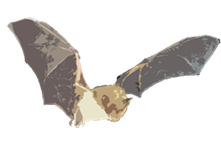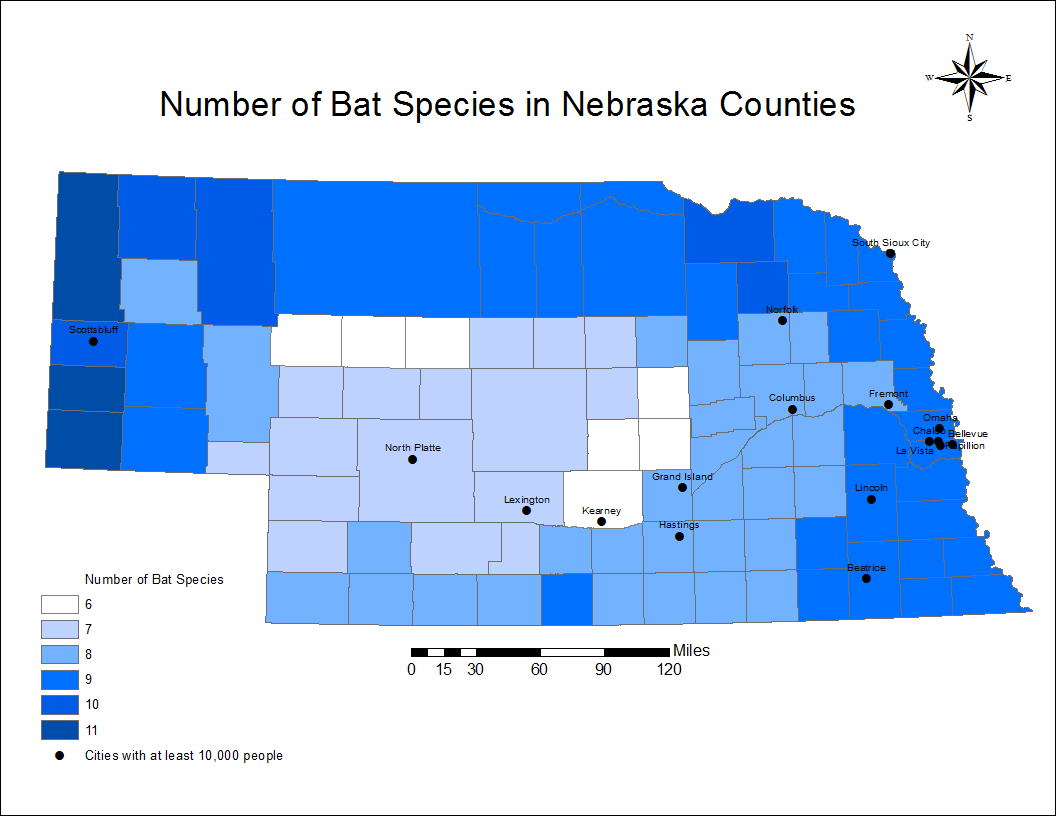Bats can have fatal collisions with wind turbines. Evaluating bat deaths at wind turbines became a priority in 2003. Hundreds of thousands of bats die every year from turbines at U.S. and Canadian wind energy facilities.
Knowing what bats are in an area and how to minimize impacts is important. Research indicates that adjusting turbine operations, such as increasing the wind speed the turbines begin turning, can help minimize the number of bats killed by wind turbines.
Thirteen species of bats are found in Nebraska. Over half of them are listed as At-Risk.
Nebraska Bat Migration Project
The Nebraska Bat Migration Project began in 2014 with the goals documenting the phenology and habitat use of bats migrating through Eastern Nebraska.
Using ultrasonic acoustic detectors to record bat "calls" the project will investigate the pathways bats follow during migration.
The Nebraska Bat Migration Project is funded by the Nebraska Environmental Trust and the Nebraska Game and Parks Commission's Wildlife Conservation Fund.
Project information can be found at: researchbat.asp

Volunteer to Help Monitor Bats
- Are you interested in helping identify where and when bats are in Nebraska?
- Would you be willing to slowly along a country road after sunset with a bat detector?
If you answered 'YES' to these questions or would like to learn more, contact windwildlife@unl.edu.
We will be looking for volunteers across Nebraska to help us collect information on bats. The information will be used at a state-level and as part of a larger, North American Bat Monitoring Program.
Nebraska Bat Publications
Benedict, R. A., Genoways, H. H., & Freeman, P. W. (2000). Shifting distributional patterns of mammals in Nebraska. Transactions of the Nebraska Academy of Sciences, 26: 55-84.
Benedict, R. A. (2004). Reproductive activity and distribution of bats in Nebraska. Western North American Naturalist, 231-248.
Czaplewski, N. J., Bailey, B. E., & Corner, R. G. (1999). Tertiary bats (Mammalia: Chiroptera) from northern Nebraska. Transactions of the Nebraska Academy of Sciences, 25: 83-93.
Damm, J. P., & Geluso, K. (2008). Use of a mine by eastern pipistrelles (Perimyotis subflavus) in east central Nebraska. Western North American Naturalist, 68(3), 382-389.
Freeman, P. W. (1983). Bats: winged maestros of the night. Mammalogy Papers: University of Nebraska State Museum, 71.
Freeman, P. W. (1991). Notes from the field: Bat Boxes. Mammalogy Papers: University of Nebraska State Museum, 6.
Freeman, P. W. (1997). Bat Research. Mammalogy Papers: University of Nebraska State Museum, 46.
Freeman, P. W. (2000). Macroevolution in Microchiroptera: recoupling morphology and ecology with phylogeny. Evolutionary Ecology Research,2(3), 317-335.
Freeman, P. W., Geluso, K. N., & Altenbach, J. S. (1997). Nebraska's Flying Mammals. Mammalogy Papers: University of Nebraska State Museum, 30.
Freeman, P. W., & Lemen, C. A. (2009). Puncture–Resistance of Gloves for Handling Bats. The Journal of wildlife management, 73(7), 1251-1254.
Geluso, K. (2006). Bats in a human-made forest of central Nebraska. Prairie Naturalist, 38(1), 13.
Geluso, K. (2010a). Survey of bats in western Nebraska: A closer look at autumn migration. Nebraska Game and Parks Commission Annual Report of the Wildlife Conservation Fund.
Geluso, K. (2010b). Wildlife spotlight – Bats of central Nebraska. Central Loess Hills Newsletter.
Geluso, K. (2011). Bats of western Nebraska: Distribution, seasonality, reproduction, and migration. Final Report. 89pp.
Geluso, K. N., Benedict, R. A., & Kock, F. L. (2004). Seasonal activity and reproduction in bats of east-central Nebraska. Transactions of the Nebraska Academy of Sciences, 29: 33-44.
Geluso, K., Damm, J. P., & Valdez, E. W. (2008). Late-seasonal activity and diet of the evening bat (Nycticeius humeralis) in Nebraska. Western North American Naturalist, 68(1), 21-24.
Geluso, K. N., & Geluso, K. (2012). Effects of environmental factors on capture rates of insectivorous bats, 1971–2005. Journal of Mammalogy, 93(1), 161-169.
Geluso, K., Huebschman, J. J., White, J. A., & Bogan, M. A. (2004). Reproduction and seasonal activity of silver-haired bats (Lasionycteris noctivagans) in western Nebraska. Western North American Naturalist, 353-358.
Geluso, K., Mollhagen, T. R., Tigner, J. M., & Bogan, M. A. (2005). Westward expansion of the eastern pipistrelle (Pipistrellus subflavus) in the United States, including new records from New Mexico, South Dakota, and Texas. Western North American Naturalist, 65(3), 405-409.
Geluso, K., Huebschman, J. J., & Geluso, K. N. (2013). Bats of the Wildcat Hills and surrounding areas in western Nebraska. Monographs of the Western North American Naturalist, 6(1), 20-42.
Geluso, K., Freeman, P., & Lemen, C. (2015). Current status of the Northern Long-eared Myotis (Myotis septentrionalis) in northwestern Nebraska. Transactions of the Nebraska Academy of Sciences, 35: 35-40.
Genoways, H. H., Freeman, P. W., & Grell, C. (2000). Extralimital records of the Mexican free-tailed bat (Tadarida brasiliensis mexicana) in the central United States and their biological significance. Transactions of the Nebraska Academy of Sciences, 26: 85-96.
Jones Jr, J. K., & Choate, J. R. (1978). Distribution of two species of long-eared bats of the genus Myotis on the northern Great Plains. Mammalogy Papers: University of Nebraska State Museum, 10(2), 49.
Lemen, C., Freeman, P. W., White, J. A., & Andersen, B. R. (2015). The problem of low agreement among automated identification programs for acoustical surveys of bats. Western North American Naturalist, 75(2), 218-225.
Serbousek, M. R., & Geluso, K. (2009). Bats along the Republican River and its tributaries in southwestern Nebraska: distribution, abundance, and reproduction. Western North American Naturalist, 69(2), 180-185.
White, J. A., Andersen, B. R., Otto, H. W., Lemen, C. A., & Freeman, P. W. (2014). Winter Activity of Bats in Southeastern Nebraska: An Acoustic Study. Transactions of the Nebraska Academy of Sciences, 34: 80-83.



